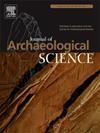On the roads and rivers of Late Iron Age Gaul: Adjusting least-cost path analysis to multiple means of transport and imprecise data
IF 2.6
1区 地球科学
Q1 ANTHROPOLOGY
引用次数: 0
Abstract
Celtic societies at the end of the last millennium BCE experienced a shift in the scale of production and exchange, leading to a revolution in mobility.
This study aims to investigate these ancient exchanges by focusing on their primary constraint: the difficulties of transportation. We seek to estimate the remoteness between sites from a merchant's perspective, considering transport costs, that is, the challenges of moving heavy and bulky goods over long distances.
Our approach is based on Least-Cost Path (LCP) estimation, which we adapt to address the various complexities inherent in applying this method to ancient transportation systems. These complexities include the multimodal nature of transportation, involving inland transport, upstream and downstream fluvial navigation, and the lack of or imprecise nature of data regarding navigable sections and transportation costs. While LCPs are widely used in archaeological contexts, a standardised methodology for calibrating them and selecting algorithmic variants remains elusive, particularly when reference paths are absent.
This article offers firstly a methodological contribution to the development and rational application of LCPs in archaeology, adapting them to the limitations of our data and the multimodal nature of goods transportation; and secondly an archaeological contribution demonstrating the crucial role of considering the constraints of ancient mobility in exploring the evolution of past societies' territories.
铁器时代晚期高卢的道路和河流:根据多种交通方式和不精确数据调整最低成本路径分析
公元前最后一千年末期,凯尔特社会经历了生产和交换规模的转变,导致了流动性的革命。本研究的目的是通过关注它们的主要制约因素:交通的困难来调查这些古老的交流。我们试图从商人的角度来估计地点之间的距离,考虑到运输成本,即长途运输笨重货物的挑战。我们的方法是基于最小成本路径(LCP)估计,我们适应了在将这种方法应用于古代运输系统时所固有的各种复杂性。这些复杂性包括运输的多式联运性质,涉及内陆运输、上游和下游河流航行,以及关于可通航区段和运输成本的数据缺乏或不精确。虽然lcp在考古环境中被广泛使用,但校准它们和选择算法变体的标准化方法仍然难以捉摸,特别是在缺乏参考路径的情况下。本文首先为lcp在考古学中的发展和合理应用提供了方法论上的贡献,使其适应我们数据的局限性和货物运输的多式联运性质;其次,考古贡献表明,在探索过去社会领土演变的过程中,考虑古代流动性的限制因素发挥了至关重要的作用。
本文章由计算机程序翻译,如有差异,请以英文原文为准。
求助全文
约1分钟内获得全文
求助全文
来源期刊

Journal of Archaeological Science
地学-地球科学综合
CiteScore
6.10
自引率
7.10%
发文量
112
审稿时长
49 days
期刊介绍:
The Journal of Archaeological Science is aimed at archaeologists and scientists with particular interests in advancing the development and application of scientific techniques and methodologies to all areas of archaeology. This established monthly journal publishes focus articles, original research papers and major review articles, of wide archaeological significance. The journal provides an international forum for archaeologists and scientists from widely different scientific backgrounds who share a common interest in developing and applying scientific methods to inform major debates through improving the quality and reliability of scientific information derived from archaeological research.
 求助内容:
求助内容: 应助结果提醒方式:
应助结果提醒方式:


